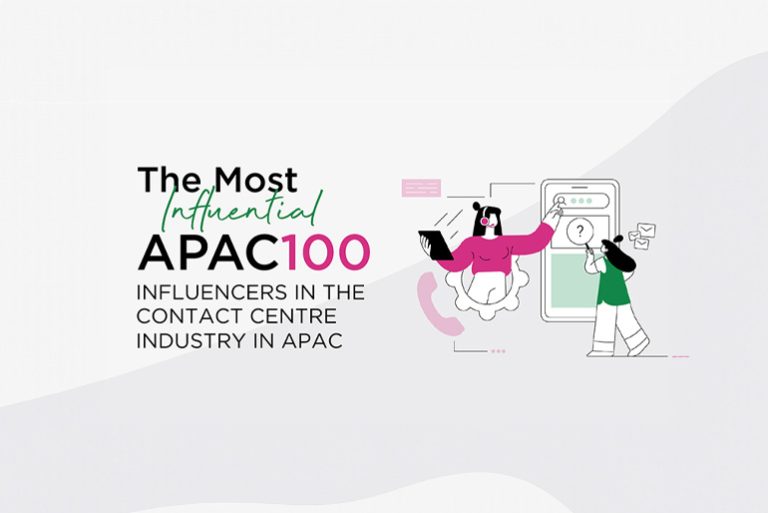RICHARD FORREST – Chairman, Forrest Contact
 Richard is a force to be reckoned within the contact centre industry. A strategic leader, generous with insights and a commitment to giving back to the industry, Richard has delivered excellence for his clients and positioned the company’s reputation as a leading provider of customer service solutions across Australia and the Asia Pacific region. Richard’s thought leadership and active participation in industry events have provided valuable insights and guidance to peers, helping them navigate the complexities of modern contact centre operations.
Richard is a force to be reckoned within the contact centre industry. A strategic leader, generous with insights and a commitment to giving back to the industry, Richard has delivered excellence for his clients and positioned the company’s reputation as a leading provider of customer service solutions across Australia and the Asia Pacific region. Richard’s thought leadership and active participation in industry events have provided valuable insights and guidance to peers, helping them navigate the complexities of modern contact centre operations.
PAUL SMITH – CEO, Citrus Group

Paul has over 30 years of experience in the recruitment industry and has assisted hundreds of local and global companies develop and implement best practice for contact centre recruitment. Paul is the CEO and one of the founders of Citrus Group, a leading recruitment company in the contact centre industry. Paul has assisted companies by providing solutions to increase customer satisfaction through effective training and WFH strategies. Paul supports the industry, sponsors research, attends industry events, and provides thought leadership that provides his clients and the broader environment with valuable insights, trends and developments.
GERARD SMITH – Chief Information Officer, Unity Bank
 Gerard is a strategic visionary with a deep understanding of the contact centre and customer experience landscape. Having worked as a CIO and CEO, Gerard understands the impact that great customer experience can have on an organisation’s bottom line. Chair of the Auscontact Board, Gerard continues to steer the contact centre industry in Australia, providing guidance, support and thought leadership to drive the industry forward.
Gerard is a strategic visionary with a deep understanding of the contact centre and customer experience landscape. Having worked as a CIO and CEO, Gerard understands the impact that great customer experience can have on an organisation’s bottom line. Chair of the Auscontact Board, Gerard continues to steer the contact centre industry in Australia, providing guidance, support and thought leadership to drive the industry forward.
ALEX BOLAND – Director ANZ Operations, COPC
 Alex has been instrumental in COPC’s growth in the ANZ region, serving as a trusted advisor to major organisations where his guidance has driven significant improvements and successes. Alex is a highly connected thought leader on LinkedIn, where his insightful content engages thousands of industry leaders. His influence extends beyond social media; he regularly shares his research findings, writes reports, and speaks at major industry conferences. With over 20 years’ of experience in CX, Alex delivers industry research and findings that help organisations better understand the industry and their opportunities to deliver excellence.
Alex has been instrumental in COPC’s growth in the ANZ region, serving as a trusted advisor to major organisations where his guidance has driven significant improvements and successes. Alex is a highly connected thought leader on LinkedIn, where his insightful content engages thousands of industry leaders. His influence extends beyond social media; he regularly shares his research findings, writes reports, and speaks at major industry conferences. With over 20 years’ of experience in CX, Alex delivers industry research and findings that help organisations better understand the industry and their opportunities to deliver excellence.
LUKE JAMIESON – Solutions Consultant Polymath, Upland Software

Luke is a contact centre and CX legend! Globally recognised for his thought leadership, Luke has won many accolades across the customer experience sector. Luke’s energy and passion is second to none. His wealth of experience, creativity, and care for people drives teams to reach for the stars. Luke has an innate ability to inspire those around him to see the possible within the impossible. He’s influential, driven, focused on the human experience, and he understands the value of contact centres in the world of customer experience. Luke’s vision around employee experience and engagement in the contact centre environment is so clear and compelling that you can’t help but feel connected to it. Having transformed some of Australia’s largest superfund contact centres in the past, Luke brings a wealth of knowledge and practical understanding combined with a contemporary and multifaceted view of customer. Sought out as an industry speaker, thought leader, podcast host, and presenter, Luke is a force within the Australian contact centre and CX landscape.
MICHAEL STELZER – Vice President ANZ, Verint
 Michael is a prominent and well-respected industry leader who provides advice, support and guidance across the contact centre and CX environment. As Vice President at Verint for the ANZ region, he has made significant contributions over his more than 35-year career. Starting life as a telesales agent, Michael has worked in both front line and vendor roles giving him a true customer-centric approach. With the ability to understand client needs and drive outcomes aligned to strategic organisational goals, Michael builds authentic partnerships with customers and vendors within the industry. Michael is a key influencer who supports the growth and ongoing maturity of the industry, and is a sought-after industry speaker and thought leader.
Michael is a prominent and well-respected industry leader who provides advice, support and guidance across the contact centre and CX environment. As Vice President at Verint for the ANZ region, he has made significant contributions over his more than 35-year career. Starting life as a telesales agent, Michael has worked in both front line and vendor roles giving him a true customer-centric approach. With the ability to understand client needs and drive outcomes aligned to strategic organisational goals, Michael builds authentic partnerships with customers and vendors within the industry. Michael is a key influencer who supports the growth and ongoing maturity of the industry, and is a sought-after industry speaker and thought leader.
JAMES JOHNSTONE – Director Commercial Strategy, Datacom
 James is an accomplished Director and thought leader who actively shares ideas and insights throughout the industry. A sought-after speaker at customer experience and contact centre events, James’ commitment to excellence and strategic vision makes him a significant influencer in the customer experience and service delivery landscape. His role involves stitching together various elements: understanding market trends, creating growth opportunities for clients, and fostering professional development for the team delivering services. James’ expertise lies in understanding how customers engage with organisations through service delivery models and technology, creating a seamless service experience for both customers and employees.
James is an accomplished Director and thought leader who actively shares ideas and insights throughout the industry. A sought-after speaker at customer experience and contact centre events, James’ commitment to excellence and strategic vision makes him a significant influencer in the customer experience and service delivery landscape. His role involves stitching together various elements: understanding market trends, creating growth opportunities for clients, and fostering professional development for the team delivering services. James’ expertise lies in understanding how customers engage with organisations through service delivery models and technology, creating a seamless service experience for both customers and employees.
TRACEY MADGWICK – Chief Customer Experience Officer, Residential Tenancies Authority

Tracey has extensive customer service experience across the private and public sector, specialising in contact centre transformation and service delivery, customer experience strategy and operations, and transactional services. Over 25 years in senior executive roles within the Contact Centre industry, Tracey is a passionate people leader who builds capability to empower staff and deliver outcomes. Finding your purpose is critical to employee satisfaction and this industry has provided the perfect opportunity for Tracey’s purpose and that is to design and deliver exceptional experiences for customers by creating an environment that provides employees the opportunity to explore, develop and connect their own purpose to that of the organisation. Outside of her role, Tracey contributes throughout her involvement at industry events, on the Auscontact Board, and as a mentor and guide to emerging talent.
Stacey Tomasoni – Managing Director, Datacom
 Stacey has played a lead role in helping clients design and execute transformational programs that integrate experience design, operational excellence, and the practical application of emerging technology. With a focus on creating enduring value for clients, Stacey has championed the design of a program of work that takes transformational change from design to execution. This initiative allows executives to actively engage in strategic dialogues that focus on what matters. Stacey, a visionary Managing Director, thrives on creating exceptional experiences for organisations. She recognises that leveraging technology is the key to solving operational challenges and enhancing employee experiences. Stacey is generous with her time and expertise, she gives back to the industry through industry events, thought leadership dialogues, mentoring future leaders, and as an active member of the Auscontact Board.
Stacey has played a lead role in helping clients design and execute transformational programs that integrate experience design, operational excellence, and the practical application of emerging technology. With a focus on creating enduring value for clients, Stacey has championed the design of a program of work that takes transformational change from design to execution. This initiative allows executives to actively engage in strategic dialogues that focus on what matters. Stacey, a visionary Managing Director, thrives on creating exceptional experiences for organisations. She recognises that leveraging technology is the key to solving operational challenges and enhancing employee experiences. Stacey is generous with her time and expertise, she gives back to the industry through industry events, thought leadership dialogues, mentoring future leaders, and as an active member of the Auscontact Board.
Nimesh Dhanak – CEO, Call Design
 Nimesh has made significant contributions to the contact centre industry, demonstrating exceptional leadership and strategic vision throughout his career. As CEO, APAC at Call Design, Nimesh has spearheaded the company’s growth and innovation in workforce optimisation. Nimesh’s influence extends beyond his organisation, as he actively shares his insights and knowledge through industry events, conferences and publications. His thought leadership has positioned him as a trusted authority in the contact centre industry.
Nimesh has made significant contributions to the contact centre industry, demonstrating exceptional leadership and strategic vision throughout his career. As CEO, APAC at Call Design, Nimesh has spearheaded the company’s growth and innovation in workforce optimisation. Nimesh’s influence extends beyond his organisation, as he actively shares his insights and knowledge through industry events, conferences and publications. His thought leadership has positioned him as a trusted authority in the contact centre industry.
IAN AITCHISON – CEO, COPC
Ian helps organisations throughout the Asia Pacific region improve their Customer Experience related operations through training, consulting, research and operational certification. Ian is a well-known and well-respected thought leader within the contact centre and CX industry. He is a critical research partner with Auscontact and other key industry organisations, providing thought provoking insights that often challenge the status quo. A passion for improving the customer experience globally, Ian recently launched the Industry Benchmarking Portal that showcases the customer view of service within the Australian market.
TANYA EGLINTON – General Manager Contact Centres, BOQ Group
Tanya has made significant contributions to the contact centre industry, particularly in the areas of leadership, transformation, high performance, outsourcing, change management, creativity, industry connection, and strategic planning. She is recognised as a human-centred and passionate leader who delivers innovative change by developing people and investing in technology. Tanya cares about the voice of the industry and the voice of the customer. Her passion for her people and her understanding of the way they work helps keep her close to what matters on the ground. She gets her hands dirty in all the innovation that she leads so that she has learnt the hard lessons to realise the success.
LUKE HUTCHINSON – Director Student Experience, TAFE SA

Luke is a well-respected industry leader who provides strategic thought leadership and insights within the contact centre and CX environment. His ability to connect problems with solutions, and anticipate barriers means he proactively influences outcomes across stakeholders, both externally and internally. Luke maintains a strong connection with the contact centre and CX industry, and promotes the power of connection, engagement, and growth through networking and thought sharing forums. Luke has provided exceptional leadership, navigating complexity across stakeholders, government policy, regulations, and underinvestment in people, technology, and physical environments.
GARY MCCOURT – Director, EGM Consulting

Gary has been an influential part of the Contact Centre and CX industry, boasting an impressive career spanning over 20 years. His innovative approach to problem-solving, strategic insights, and commitment to leveraging technology for business transformation sets him apart. Gary’s skills are sought after across the industry, with a current focus on helping SMEs and contact centres ready to take the next step in their growth. Always an early adopter of technology, Gary continuously seeks the next best thing to help people succeed. He is a vocal advocate of service excellence, and constantly looks to challenge the status quo.
FRAN SOUTHWARD – CEO, Auscontact

Fran is the CEO of Auscontact, the Australian Contact Centre Association. A strategic leader, Fran has experience leading large scale operational organisations, strategic programs and transformational change initiatives. An industry leader with vast knowledge about all things Contact Centre and Customer Experience, Fran provides advice and support to organisations throughout the Asia Pacific region. Driving the industry forward, Fran continues to challenge the status quo, providing a platform of experts to Contact Centre operations throughout Australia.
TEGAN JUDGE – Manager, Contact Centre and Operations, nib Travel

Tegan is a standout figure in contact centre management, renowned for her exceptional achievements and leadership prowess. With a track record marked by numerous accolades, Tegan has solidified her reputation as an industry luminary. Tegan is an innovative leader who challenges her people to deliver exceptional service every day. With a growth mindset, a curiosity that sees her challenge the status quo and look for new ways to future proof her organisation, Tegan has a profound impact on her peers and the teams around her. A renowned expert, Tegan is a sought-after speaker, industry thought leader, and advisor who supports the growth and development of others.
TIM POWELL – Head of National Contact Centre & Payments, Teachers Mutual Bank Limited
Tim has built a fantastic career within the customer contact industry, and is consistently elevating his team’s focus and capability to bring leading edge principles and practices to life in his contact centre. He has been an active advocate for the customer contact community, participating in and chairing the Auscontact NSW Committee for some years prior to joining and serving on the National Board. Tim is trusted, takes accountability to drive performance and member/customer satisfaction. Tim is strategically aligned to the organisation’s goals and improved member/customer experience.
ANGELO AZAR – Chief Operating Officer, Honey Insurance
Angelo is a strong leader with great industry presence. He is consistently sought out for support, mentoring, coaching and advice, which he generously provides. A leader who challenges current practice thinking in a bid to innovate and push boundaries. Angelo is a true customer advocate, he empowers those around him to pursue excellence and reinvent what we define as customer excellence. Angelo is a collaborative, human centred leader who is always looking to learn, grow, and develop.
MIKE POWRIE – CEO and Founder, CloudWave Pty Ltd
Mike is a contact centre and CX specialist. He understands the environment and knows the challenges organisations are facing as he helps them navigate this with technology and innovative solutions. Seeing organisations challenged by expensive and rigid technology options, Mike disrupted the market with Cloudwave. Mike helps contact centres across every vertical market evolve into world class operations, improving the way customers are served and services are delivered. As the CEO and founder of CloudWave, Mike is a beacon in the industry, hand holding large enterprise, Government and SMB organisations through the challenging waters of digital transformation. He has driven a central theme of how important the digital front door of an organisation is, and demonstrates how improvements in CX can positively impact top line revenues, reduce customer churn and enhance the employee experience
RACHEL AZIZ – Chief People & Culture Officer, recoveriescorp
Leading with empathy in her role as the Chief People & Culture Officer, Rachel is a valued Executive across the recoveriescorp group. With specific expertise across capability, talent management, OH&S and people governance, Rachel is known as the contact centre people guru. Putting the contact centre at the heart of organisational decision making, Rachel is valued for her thought leadership throughout the industry. Rachel is a trusted strategic partner, and operational expert in all things People & Culture. Peers seek her out for executive coaching and strategic advice, and people across the group seek out her guidance, support, mentoring and laughs.
MICHAEL CLARK – Co-Founder and Principal Consultant, CXTT Consulting
Michael is an industry veteran who continues to lead innovation and improvement as a coach, consultant and facilitator. Michael brings decades of experience and thought leadership, assisting clients from across government, NFP and private sector to improve outcomes for their people and their customers. Michael is a well-regarded influencer within the industry and is regularly sought out for speaking engagements, sharing insights and to collaborate on projects. He is a regular contributor to events and activities within the CX and Contact Centre industry, he promotes the industry at every opportunity and is considered a thought leader amongst thousands of followers on LinkedIn. Michael represents the best of the industry as he continuously learns and evolves – much like the industry we work within.
ANETA FIELD – Senior Manager Customer Support, Honey Insurance
Aneta is an absolute powerhouse. A considered leader, she builds strength in those around her, empowers and trusts their judgment, supporting them with the guidance and advice they need to succeed. Aneta has a leadership style that focuses on her people, knowing that if she gets that right, the business will take care of itself. To this end, her authentic leadership style challenges and inspires, creating mutual obligations that deliver exceptional organisational results. A humble operator, Aneta is committed to her own growth and development. She is never afraid to be wrong, and is always looking for ways to enhance her impact on her people. Definitely one to watch
KRISTINA PUSHIK – Customer Centre Manager, Bingo Industries
Kristina has been in the contact centre industry for 14 years, leading teams within banking, stockbroking, insurance and now waste management and recycling sectors. She builds successful teams who can deliver an outstanding experience to their customers while passionately advocating for the growth and talent development of her people. She delivers generously beyond her role; running programs that support growth in women within her organisation, mentors and guides a whole generation of future leaders with people-centric leadership.
ROD LESTER – Managing Director ANZ, NICE
Rod has contributed extensively to the industry and demonstrated remarkable achievements throughout his career. A transformative leader within the industry, Rod drives significant advancements through strategic innovation and visionary leadership. He inspires and challenges organisations throughout the region, driving change beyond the boundaries of his organisation. His influence extends across the industry, where he is recognised for both his accomplishments and his ability to galvanise others towards shared goals. Rod doesn’t settle for the status quo; instead, he is constantly pushing the envelope, exploring new technologies, strategies, and experiences, and finding better ways to serve customers and enhance operational efficiency.
AILEEN DAY – Founder, Aileen Day Consulting
Aileen has been working within the contact centre and customer experience environment for more than 15 years. With a unique combination of skills including public relations, customer service, clinical hynotherapist and clinical psychotherapist, Aileen challenges organisational thinking and capability to set them up for success. Shifting culture and organisational approaches, Aileen supports organisations to revisit their perception of customer service excellence, streamlined services, and reframe what success could look like. Aileen is an active influencer and contributor to the CX industry.
NADIA YOUNAN – WFO Solutions Manager APAC, NICE
Nadia is an industry expert, renowned for her technical prowess and her authentic and genuine nature. She has an exceptional ability to distinguish between fleeting trends and strategies that deliver genuine value to customers. This discerning approach has earned her the trust and respect of her peers and clients, cementing her reputation as a knowledgeable and reliable industry leader. Nadia has been instrumental in raising awareness of WFM within the industry. She is a dedicated product advocate, leveraging her deep knowledge and passion for WFM to drive enhanced results for organisations. Her participation in roundtables, discussions, and panels has positioned her as a thought leader, driving a greater understanding of WFM’s value and capabilities.
MICHAEL BRADLEY – Strategic Engagement Leader, Datacom
Michael was an AI thought leader and industry advocate before it was the cool thing to be. Michael’s insights and advocacy has shaped the AI landscape within the sector, supporting organisations to better understand how AI deployment can be impactful, meaningful and solve pressing challenges. With deep technical expertise, Michael explored the intricacies of human language and decoding its complexities alongside the team at Cognigy Software. A true technical expert with the human skills that allow him to identify opportunities to enhance customer outcomes and organisational results.
JULIE-ANNE HAZLETT – Head of WFO Strategy, Call Design

Julie-Anne has been in the Contact Centre, CX and WFM industry for more than 2 decades. She has worked across the globe, specialising in implementing best practice workforce optimisation, performance management and quality. Julie-Anne has coached and trained many WFO professionals and helped organisations get the most from their technology investment. Incredibly generous, Julie-Anne supports the industry through speaking engagements, industry events, and
providing guidance and mentoring to up and coming leaders.
MELLISSAH SMITH – Founder & Managing Director, Marketing Eye

Mellissah is the Founder of Marketing Eye, an international marketing consulting firm established in 2004 that specialises in companies looking to fast-track business growth. Working closely with large organisations within the contact centre and CX industries, Mellissah supports the industry generously with her time and expertise. Her company provides businesses with a complete outsourced marketing department, that takes your budget, resources and brand and packages it with creativity, developing high impact marketing campaigns and brand leadership. She is a global marketing influencer who has been awarded the “Innovator of the Year” 2022 at WiT Awards.
MEI-LING CHEONG-NEPIA – Head of Service and Operations, Australian Ethical
Mei-Ling is an experienced, successful, and influential leader who has worked across multiple organisations throughout her career. She is well respected as a leader and peer across the business and externally within the industry. Mei-Ling invests time into her people to bring the best out of them and support their future growth, setting them up for success. She earns respect and influences the people around her with her honesty, passion for people and customer service. With an innovative mindset, dedication to excellence, and unwavering commitment to advancing the contact centre and CX industry, Mei-Ling is generous with her time and knowledge. Her impact is profound and far-reaching, making her a pivotal figure in shaping the future of customer service.
JOSHUA CURTIS – Centre Manager Customer Care, Super Retail Group
Joshua is dedicated to enhancing standards, nurturing talent, and fostering a supportive work environment and team culture where his people will succeed whilst delivering exceptional results for his organisation. He is passionate about elevating the contact centre within his organisation and has brought to life the ‘voice of customer’, making the customer care centre a strategic asset within the business. Joshua challenges the status quo, pushes the envelope around innovation and strategy to drive meaningful outcomes. A passionate advocate for developing others, Joshua invests in his people to ensure their success. Joshua is often seen presenting at industry events, conferences, and thought leadership forums, he gives back to the industry as a member of the Qld Auscontact committee and is definitely a leader to watch.
TOBY ELLIS – Head of Customer Services, AMP
Toby is an internationally experienced people leader who creates environments where people are inspired to innovate, challenge, and thrive whilst creating exceptional customer experiences. Toby empowers his people, creating opportunity for development, and celebrating success at every opportunity. A leader with influence, Toby’s enthusiastic passion is contagious. He builds exceptional relationships with his authentic style, creating an environment where people come first. Outside of his role at AMP, Toby is an advocate for community, people, and culture. He is the founder of Deadly Rugby and encourages others to give back to the community. A well respected professional, Toby is a sought-after public speaker, contributes to the industry as a thought leader, and always advocates for the success of others.
TIM BUZZA – Director Workplace Flexibility, Verint
Tim is one of, (if not the), biggest champion for flexible work in the contact centre environment. A contact centre expert, Tim is the creator of Timeflex technology that helps in better rostering people to match the modern ways of working. He is an incredible public speaker and thought leader. He is wise and measured but above all, Tim leads with kindness. Tim is not always the front man, often the guiding hand behind the brilliance. He influences through action and conviction at all times. He is someone anyone starting their career within the industry should look up to.
ROWENA POWELL – Formerly Director Operations, Serco
Rowena has held various senior leadership roles within the contact centre and CX industry. An outstanding people leader and operational executioner, Rowena is a force to be reckoned with. Leading complex organisations within the BPO environment, Rowena brings commercial acumen, exceptional leadership skills, and a deep understanding of customer together to drive a high-performance culture and deliver exceptional results. Rowena has influenced many industry careers and is still a ‘quiet achiever’, rarely taking credit for her amazing contribution to the industry. We are excited to see where to next for Rowena as her experience would see her well placed to deliver successfully in any environment. Watch this space!
NICK WALKER – Owner Director, Tenacity CX
Nick is the Owner, Director at Tenacity CX. His contributions through training, recruitment, and consulting have significantly elevated industry standards and improved organisational outcomes. Nick is focused on fostering talent, driving innovation, and enhancing customer experience across the contact centre and CX field, and has successfully placed hundreds of professionals in key roles within the industry. Nick is often seen at industry events, speaking at conferences and on expert panels, providing insights and advice to the broader community.
SHARON MELAMED – Manager Director, Matchboard
Sharon is an industry expert and entrepreneur, who has established a personal brand anchored in integrity and professionalism. Sharon’s key achievement is the development and successful execution of Matchboard, an innovative matchmaking platform helping organisations connect with perfect match suppliers of contact centre services and solutions. As the founder of Matchboard, Sharon has done the contact centre industry proud through the elevation of her innovation being recognised in the broader business world. She is always connecting people, whether for career opportunities, mentoring or to fulfil a business requirement. A true advocate for the industry, Sharon is a well-respected thought leader who continues to make time for those around her.
EMMA HOLDEN – Director, Tenacity CX
Emma leads a contact centre and CX specialist recruitment agency that is renowned for placing hundreds of high-quality candidates in key roles across the industry. Her ability to match the right talent with the right opportunities has significantly impacted the success of numerous organisations. Emma’s focus on quality and precision in candidate placement has led to a notable increase in client satisfaction and retention. Her ability to inspire and mentor her team and peers has created a ripple effect of positive change and professional growth.
RAZ BOOMGAARD – General Manager, Newscorp
Raz is an experienced international customer contact channel executive leader. He has a demonstrated a history of working in the telecommunications and media industries, and has recently joined Newscorp as their General Manager. Skilled in strategic business planning, operations management, and strategy design, Raz is transforming customer interactions one step at a time. Building a culture of trust and employee value, Raz focuses on building high performing teams with the right skills to create authentic customer relationships. A strong people leader, Raz is a well-respected professional with a focused interest on how technology and innovation shape customer experience outcomes, whilst driving business bottom line growth.
CHRISTINE GOURDOULIS – Customer Service Manager, Sigma Healthcare
Christine’s authentic and vulnerable leadership style fosters trust and collaboration, creating an environment where teams thrive. Her leadership style has established a foundation for enhanced operational efficiency and sustained engagement. Known for her never-say-die attitude, Christine embraces new approaches and consistently achieves results. Her exceptional ability to rally people and gain their commitment is key to her success. Christine’s career is marked by her dedication to excellence, collaborative leadership, and significant impact on the organisations she has worked with, showcasing her adaptability and commitment to positive organisational outcomes.
DARREN SUTTON – Associate Director Customer Service, Healthshare

Darren is an accomplished CX senior leader with a wealth of experience drawn from a rich career spanning the Telco, BPO, Mutual, FMCG, Utilities, and Government Health sectors. Darren possesses strong leadership skills combined with a growth mindset and personality that allows for easy interaction with his team, peers, execs, shareholders and customers. Darren is a results-focused C Level professional, with a strong strategic vision aligned to operational excellence and ROI. He is a commercially astute and people focused leader who understands the balances that need to be achieved in driving high levels of high customer satisfaction, quality and shareholder value. Darren focuses on the impact his leadership has, recognising that at the heart of what we do, are the human beings we lead and serve.
KELLY DONKER – Senior Manager Customer Service, Lotterywest

Kelly is a strong, people-centric leader, committed to making a difference in every organisation she works within. Strategically positioning her organisation to succeed, Kelly empowers her people to deliver exceptional results and keep the customer at the centre of every interaction. Building a culture of curiosity, creativity, and collaboration, Kelly consistently promotes customer-centric strategies and best practices throughout the industry. Passionate, enthusiastic, and a committed life-long learner, Kelly is a great asset and leader.
DANIELLE MCCARTNEY – Senior Manager, Risk and Compliance, Honey Insurance

Danielle defined, created, and structured the risk appetite of Honey Insurance. Being the only risk and compliance manager in the organisation, Danielle has helped transform an idea of a successful insurance startup into a reality. Danielle has elevated the organisation and set a new standard for excellence in compliance communication and continuous learning within our industry. What sets Danielle apart is her deep understanding of the insurance sector. She goes above and beyond to ensure that compliance is not just about ticking boxes but about empowering employees with practical knowledge that can be applied every day, designed into processes and systems. Her proactive stance on staying ahead of regulatory changes has been invaluable, keeping the organisation informed and compliant in a rapidly evolving landscape.
Deepak Selveratnum – Chief Operating Officer, Customer Service Audit
 Deepak is a pioneering force within the contact centre and CX industry, having created Snapshotz in 2009, the first web-based audit and benchmarking tool for the contact centre and help desks, followed by the RemotAbility app in 2021, designed to assess remote work capabilities. With a deep understanding of the environment, extensive knowledge and expertise of how optimised contact centres operate, Deepak is a passionate advocate for the health and safety of frontline staff.
Deepak is a pioneering force within the contact centre and CX industry, having created Snapshotz in 2009, the first web-based audit and benchmarking tool for the contact centre and help desks, followed by the RemotAbility app in 2021, designed to assess remote work capabilities. With a deep understanding of the environment, extensive knowledge and expertise of how optimised contact centres operate, Deepak is a passionate advocate for the health and safety of frontline staff.
GERRY TUCKER – Director of Sales Large Enterprise, Sprinklr
Gerry is an experienced contact centre and CX executive with a deep understanding of the environment, the challenges that organisations face, and ways to address these with technology and innovative operating models. This experience enables Gerry to build the right relationships with customers, building trust and confidence as he supports them with design solutions that build on existing capabilities to navigate through the dynamic and constantly changing landscape. Recognising the value of emerging technology and innovative applications, Gerry helps organisations navigate the challenges of cost minimisation requirements, the need for tailored customer solutions, and utilising the myriads of data available to build on results. A seasoned industry professional, Gerry is often seen speaking at industry events and providing thought provoking commentary on industry challenges.
JAMES WITCOMBE – Director, SMAART Recruitment
James is a passionate advocate, an accomplished professional, and a generous contributor to the contact centre and CX industry. A Director at SMAART Recruitment, James actively drives excellence within the industry through strategic people placement across multiple verticals. James provides support to individuals within organisations through his Contact Centre Mentoring program, through the ‘Candidate Coach’ program that supports growth and development for candidates looking to enter the industry, and through the production of the Contact Centre Best Practice Report. A renowned public speaker, industry thought leader, and advocate for the development and growth of people within the industry, James is a well-respected leader who continues to look for ways to support the growth and success of organisations across the industry.
SIMON KRISS – Chief AI Officer, Simon Kriss AI
Simon is a passionate, engaging executive and thought leader who works with Company Boards and C-Suite Executives on innovation in their customer experience. Simon has a wealth of knowledge of the contact centre and CX environment, having led large scale operations around the world to deliver exceptional results and inspired customer experiences. Simon is a published author, a well-respected voice on AI globally, and a customer experience advocate who supports organisations to rethink their landscape to enhance their strategic remit. Simon provides insightful thought leadership, can often be seen presenting keynote addresses nationally and internationally, and is a sought-after commentator across the AI and customer experience environment. Simon has always supported the Contact Centre and CX industry and is incredibly generous with his time and expertise.
ANNIE BRETT – Head of Customer Contact Centre, Great Southern Bank
Annie is a powerhouse within the industry. A true people leader known for leading highly successful teams, developing and implementing strategies to directly impact the bottom line, and building the next generation of successful leaders through targeted support and strategic development. Annie’s enthusiasm and passion for success is contagious and inspires others to strive to deliver results. Annie is innovative, driven, and curious, constantly looking for ways to take her operation to the next level. Annie can often be seen presenting at industry events, speaking at conferences, and taking part in expert panels. Definitely one to watch.
GREG CHONG – Chief Customer Officer, Booktopia
Greg has significantly impacted the contact centre industry through his expertise in culture-building and performance enhancement. He shares his knowledge at numerous industry conferences, shaping discussions on best practice, emerging trends, and innovative strategies. His engaging style and deep insights have established him as a thought leader in the field. His ability to lead and inspire his team is highlighted by his commitment to nurturing talent and fostering a positive work culture. His dedication to customer satisfaction and advocacy is evident in his approach to managing his teams. He prioritises delivering the best outcomes for customers and consistently strives for excellence in customer service.
SCOTT TASKER – Group Contact Centre Manager, Lite ‘n Easy
Scott is a results-driven professional with a deep understanding of the contact centres and CX environments. With more than 25 years’ experience and a track record of success, Scott is a results-oriented leader who challenges his people to innovate and change in line with the expectations of their customer base. Experienced in building strong relationships with key stakeholders, Scott influences strategically and gets results. A passionate advocate for the customer, Scott contributes thought leadership content throughout the industry and is often seen at industry events, sharing his knowledge and expertise.
CHRISTINE INKSTER – Manager Student Engagement, TAFE SA
Christine has led significant and enduring change programs across private, local government, and education sectors. Christine’s ability to apply change leadership skills across industries demonstrates a robust understanding of methodologies and managing people. Christine brings more than 25 years of experience in the Customer Service and Customer Contact industry, Christine has deployed exceptional coaching skills to grow emerging leaders, and existing leaders alike, building the confidence and capability of the next generation of leaders within the industry
MELISSA VAN DER BURGT – Head of Customer Experience Centres – Direct & Specialist Skills, Allianz Australia
Melissa is a highly resourceful, versatile and resilient management professional with over 15 years of experience building and leading high-performance teams in diverse industries. With a proven track record of transforming underperforming teams and programs, Melissa builds capability in others, creates a high-performing culture, and empowers her people to succeed. Melissa is a human-centred leader who focuses on the success of those around her, investing in their development, and supporting them as they learn. Uniquely gifted with a talent for connecting with people and the ability to earn their wholehearted effort, Melissa is a well-respected leader who inspires her team and leads them to achieve exceptional results.
MEGAN PAPADOPOULOS – General Manager of Customer Contact, Bendigo & Adelaide Bank
Megan leads the provision of general and specialised centralised customer service functions for Bendigo and Adelaide Bank across a range of brands and functions. An accomplished professional with a deep love for contact centre operations and customer service, Megan inspires her teams to keep the customer at the centre of every interaction. An influential leader, Megan ensures that decisions focus on the customer experience at the design phase including through technical implementation and product design, and has successfully enhanced the visibility of the contact centre and customer service function throughout the organisation. A well-respected leader with extensive expertise, Megan is a sought-after industry thought leader who contributes to the ongoing development and success of the industry
MATTHEW PENMAN – General Manager Customer Service, Auto & General
Matt has been actively involved in the contact centre industry for more than 20 years. A passionate advocate for the industry, Matt has been an active member of the Australian industry body including as a Board member, since 2006. A highly skilled and customer-focused General Manager, Matt empowers his people to deliver, and supports their development and growth. Establishing strong relationships with his people, Matt designs processes that increase efficiency and the quality of contact centre operations, whilst influencing organisational design that streamlines and enhances the customer experience. A strategic thinker, Matt thrives on being an integral part of planning and direction setting to improve processes, drive new businesses and growth, achieve targets and ensure continued success.
KRISTY CANNING – General Manager of Service Operations, icare NSW
Kristy is an exceptional leader with more than 20 years experience leading large-scale operations within the contact centre and CX industry. Kristy is committed to showcasing the value that contact centre operations bring to an organisation and their impact on the customer experience. A strong advocate for change, Kristy supports organisations to utilise new and emerging technology and operating practices to enhance efficiency and organisational results. Empowering her teams to deliver, Kristy is a collaborative leader who is investing in the success of her people. Kristy can often be seen speaking at industry conferences and events. She is a member of the Auscontact Board and provides guidance and support to help drive the industry forward.
MICHEL STUTZ – Manager Contact Centre Technology, Jetstar
Michel is a commercially astute senior leader and strategic business development professional in the contact centre industry and corporate related services. With a reputation for innovative leadership of complex and multi-faceted operational businesses, Michel has more than 20 years of experience working in multi-cultural global business environments. Michel supports the industry in Australia, he sits on the Auscontact Board where he provides guidance and support to the industry body. A track record of excellence in leadership and stakeholder management, Michel consistently delivers industry leading business performance through growth, efficiency and enhancement of business capability in highly competitive environments.
DANIEL TAYLOR – CEO, CCSG Group of Companies
Daniel is a well-respected industry leader who leads by example and is always willing to go the extra mile to help those in the industry better their organisation and themselves. As the CEO and Founder of the CCSG Group of Companies, Daniel has led the growth of the organisation in acting for Australia’s leading organisations in late-stage debt recovery. Daniel has been responsible for the strategic direction and focus of the group, building industry leading teams in both Australia and in the Philippines who challenge the norm. Constantly looking at ways to do things differently, Daniel does not accept “this is how we have always done it”. Daniel leads a collaborative and diverse team focused on success.
IAN DE SOUSA – CEO, Synergy Enterprise Solutions
 Over his 25-year career, Ian has been instrumental in shaping some of the largest and most complex contact centres in Australia. His strategic insights and technical acumen have particularly impacted major institutions such as banking, emergency services, and various government services across the country. He is a trusted advisor and strategist in the realm of contact centre technology, and his ability to navigate complexities and deliver impactful solutions has solidified his position as a key influencer in shaping the landscape of customer service in Australia.
Over his 25-year career, Ian has been instrumental in shaping some of the largest and most complex contact centres in Australia. His strategic insights and technical acumen have particularly impacted major institutions such as banking, emergency services, and various government services across the country. He is a trusted advisor and strategist in the realm of contact centre technology, and his ability to navigate complexities and deliver impactful solutions has solidified his position as a key influencer in shaping the landscape of customer service in Australia.
MARK GALLEN – Director, TactiCall Recruitment
Mark is co-founder and Director at TactiCall Recruitment. Bringing more than 20 years of industry experience to the table, Mark is a recognised expert in the contact centre and CX recruitment sector, supporting organisations with talented customer focused professionals across all roles that impact the customer experience. TactiCall support some of the biggest brands internationally and within Australia across private and public sectors due to their understanding of the industry, of organisational culture and their ability to match high quality candidates to roles on offer. Mark is an avid supporter of the industry body, he is incredibly generous with his time and expertise, helping the industry within Australia thrive. A well respected professional, Mark has a deep understanding of the changing labour market, knows what organisations need to succeed, and delivers this every time.
LUKE SALMON – Account Executive, Calabrio
Luke supports organisations to deliver enhanced results through strategic design and planning, helping them to get the most out of their technology investment. A customer centric executive, Luke works to solve organisational challenges, applying creative and innovative approaches to age old problems. Recognising the impact engaged and well supported agents can have on any operation, Luke works with organisations to identify opportunities to exceed customer expectations and boost workforce efficiency with data, analytics and emerging technology. Luke is known across the industry, he provides support and coaching to emerging leaders, recognises talent and provides his expertise at regular industry events. Luke builds genuine relationships throughout the industry, looking to help drive results and continuously enhance the capability across contact centres in the region.
KIRSTY FONSDITURI – Head of Client Services, NobleOak
Kirsty is a people centred leader who has been instrumental in elevating the positioning of the contact centre within NobleOak. Authentic, transparent and visible, Kirsty empowers her people to deliver service excellence, keeping the customer at the heart of everything they do. Approachable, balanced, and measured, Kirsty is not afraid to roll up her sleeves and get her hands dirty if thats what is needed. Responsible for introducing innovative best practice within her centre, Kirsty is constantly looking for progressive ways to build capability and expertise across the team. A great leader who continues to get the best out of her people, delivering great results for her organisation.
TONY WU – CEO and Co-founder, Weploy
Tony is the co-founder and CEO of Weploy, Australia’s leading high volume Customer Service and Contact Centre staffing platform. A well-respected and innovative leader, Tony has a passion and enthusiasm that is contagious, challenging those around him to strive and excel at every opportunity. Tony understands the contact centre and CX environment, and he has built a business around successfully disrupting the labour market, always looking for ways to innovate and challenge the status quo. Tony supports the industry, giving back through his role on the Victorian State committee where he supports organisations to introduce best practice and contribute to industry thought leadership.
FRANCES QUINN – Founder, Athena Consulting
Frances is the Founder of Athena Consulting where she utilises her expertise to support time-poor founders and executives to drive scalable profitability through customer excellence, operational efficiencies, technology optimisation and process automation. With more than 20 years’ experience, Frances is a well-respected industry professional who continues to shape the capabilities and skills of organisations to deliver enhanced customer and employee experiences. Providing strategic advisory services, industry leading training programs, and tailored strategic initiatives, Frances shows others how to harness their purpose and passion to drive productivity.
NICK COWL – Head of Everyday Banking, ANZ
Nick is the Head of Everyday Banking at ANZ. A passionate leader with deep experience leading large and complex contact centre operations, Nick looks to drive organisational results through people centred strategies. He is a key influencer who successfully showcases the potential of direct channels as strategic organisational asset, and provides a point of difference in driving customer advocacy. Creating highly engaged teams across sales and service functions, and delivering outstanding results through voice, digital, inbound and outbound customer interactions, Nick challenges his people to look for new ways to operate and innovate. Nick supports the broader industry, he provides thought leadership commentary at executive events and is always sharing his knowledge and expertise.
SHELLEY FLETT – Owner Director, Shelley Flett Pty Ltd
Shelley is a published author, podcaster, leadership coach, professional speaker and industry powerhouse. Empowering leaders to drive their own development journey, Shelley draws on more than 20 years of industry experience to transform a generation of leaders, taking a holistic approach to connect head, heart and gut. Enthusiastic, passionate and purposeful, Shelley challenges you to rethink how to deliver operational excellence, encouraging leaders to reframe and reset as they take the journey to dynamic leadership. Shelley continues to give back to the industry, she can often be seen presenting at industry conferences, contributing thought leadership through a variety of forums, and showcasing exceptional leaders through her Podcast Series.
KUNAL RAHALKAR – CEO, Datagamz
Kunal is the CEO at Datagamz, the first enterprise gamification company in Australia. Datagamz has developed a powerful, engaging digital gamification platform. With a deep passion for the contact centre industry, Kunal is constantly looking for ways to improve productivity and engagement across the sector. Taking a keen interest in seeing organisations improve engagement with their staff and employees, Kunal supports leaders to optimise their operations, systems and processes with a view to reducing ‘noise’ and streamlining the customer journey.
HELEN CROSSAN – Head of Member Services, Australian Retirement Trust
Helen has recently joined the Australian Retirement Trust team, bringing a wealth of experience that will set her up for continued success. A trusted team player, Helen is an authentic leader who builds engaged and effective cultures, where teams are inspired to succeed. A staunch customer advocate, Helen is a commercial and pragmatic business professional with the ability to quickly understand and identify opportunities within the environment and implement practical solutions that enhance outcomes. An independent thinker, accountable and dynamic leader, Helen builds exceptional relationships that support organisational success.
TODD GORSUCH – CEO, Customer Science
Todd is the founder and Chief Executive Officer of Customer Science, a consulting and professional services firm founded to drive customer service transformation. A contact centre expert with more than 25 years’ experience, Todd has worked across the public and private sector, helping organisations create customer interactions that build loyalty, minimise effort, and deliver bottom line outcomes. Todd is a passionate advocate for the contact centre and CX industry, and a member of the NSW Auscontact Committee. He is often seen at industry events where he generously provides insights and guidance to support growth and success.
MATT HARVEY – Senior Manager, Communications Centre, Edith Cowan University
Matt is an engaging, approachable and passionate business leader who drives a high performing, engaged and human centred culture. A future focused manager, Matt builds strategic success through the development of streamlined and well-functioning operating models underpinned by lean processes and channel focused customer experiences. An advocate for the coaching and development of people, Matt is an authentic and genuine leader who has created an empowered environment where people are encouraged to challenge the status quo, to look for innovative solutions, and where they are supported to grow and develop.
FRANCES CAWTHRA – General Manager, Australia Post
An inspirational C-Suite executive leader with demonstrated success leading complex and multi-dimensional service organisations. Frances has an extensive track record of creating, influencing and implementing organisational strategy in public and private sector organisations. With proven experience leading successful transformational change and harnessing potential, Frances has a deeply embedded understanding of what an optimised customer experience looks like and translates this within her organisation. Delivering exceptional results in high pressure dynamic work environments, Frances is an influential leader who invests in the success of others, inspires innovation and solution-focused action.
CATHERINE VERONESI – Manager Customer Service, City of Sydney
Catherine is an accomplished customer service, CX and digital transformation leader, experienced in both private and public sectors. Specialising in optimising customer service channels and driving digital service transformation and operational efficiency, Catherine has delivered high profile programs that have had huge impacts on the customers serviced by her team. Passionate about cultivating strong customer relationships and empowering teams to excel, Catherine delivers strategies that enhance both service quality and customer experience while reducing costs and boosting organisational success.
JODIE BEDOYA – Director, eMatrix
Jodie is an experienced Director and one of Australia’s leading customer engagement specialists. An expert in designing and delivering state-of-the-art training that covers some of the most challenging elements within the contact centre and CX environment. Supporting organisations to achieve beyond their expectations, Jodie brings an authentic style that engages and connects with those around her. Teaching effective collections and vulnerability training, Jodie utilises the psychology of successful collection conversations to build capability. Jodie developed the eMatrix business to help organisations build capabilities in a range of specialised areas from collections and vulnerability through to leadership and resilience.
DAN EDWARDS – Director Health Insurance Channels & Growth, Bupa
Dan is a global leader with more than 20 years’ executive experience across multiple large-scale operations. Building, leading and optimising customer operations at scale, Dan is a well-respected expert renowned for his innovative thinking and progressive thought leadership contributions. Dan focuses on creating, inspiring and enabling teams to deliver service and sales moments that customers feel great about. Dan thrives in innovation-inspired cultures and relishes the chance to lead growth and change using data and technology to transform customer strategies.
MONICA RYAN – Vice President ANZ, Concentrix
An exceptional leader, business strategist and outcome execution expert, anyone who has worked with Monica will understand why she is in the Top 100 Influencer List. Driving exceptional results for Concentrix, Monica Ryan has a deep understanding of the value of getting the customer experience right. With more than 20 years’ experience across the contact centre and CX environment, Monica provides strategic leadership in the ANZ region. Monica successfully leads the delivery of all people, client and business outcomes. Always generous to others building careers within the industry, Monica ensures there is time to invest in others and showcases the opportunities available within the CX and Contact Centre industry.
JOSHUA ELLIS – Global Head of Contact Centres, OfficeHQ
Joshua’s achievements in the contact centre industry have been seen across all industry types and through his transformative work in leading large-scale Customer Experience initiatives. As a leader, Joshua has pioneered the adoptionof cutting-edge technologies coupled with developing contact centre talent to remove friction and create seamless interactions for the organisations he works for. His advocacy for implementing technology solutions, such as chatbots and virtual assistants, has streamlined processes, reduced response time, and optimised resource allocation. Joshua’s commitment to professional development and talent cultivation sets him apart as a true industry leader
STEVE TARGUS – Contact Centre Operations Manager, MYOB
Steve leads the MYOB team to deliver exceptional service for their customers, driving them to deliver results in line with the organisation’s mission to drive down customer effort. Steve has built teams of people who are passionate about their roles, aligned to the organisational vision, and commit every day to redefining great customer service. Bringing a unique sense of joy to the workplace, Steve showcases that reflecting on your impact, defining who you want to be as a leader, and attacking your role with passion and purpose, drives great results for customers and your people. A great example of how to lead from a human-centred position to achieve results.
STUART BEAUMONT – Executive General Manager Customer Service, Suncorp
Stuart has more than 20 years’ experience leading teams to deliver successful business and customer focused outcomes. A proactive and inclusive leader, Stuart empowers his people to be curious, challenge existing processes and look for ways to streamline and reimagine the customer experience. With a passion for digital and technology, Stuart has a strong track record for delivering automation and driving enhancements through service-focused design. A well-respected leader, Stuart creates environments where people thrive, grow and succeed.
ELISA LURATO – Chief of Community, Retail & Supporter Experience, World Vision
Elisa has more than 20 years’ of experience across multiple sectors including motoring, retail, luxury, telecommunications and not-for-profit. An integrated marketing all-rounder for both B2B and B2C channels, Elisa has extensive experience across service delivery, brand management, digital delivery, customer experience and operations. In a challenging environment, Elisa continues to achieve organisational goals and deliver results. A strategic and creative problem solver, Elisa challenges her people to continue to exceed targets and goals, daring to do what others say is impossible.
PETER GRIST – Managing Director, Grist Consulting
Peter is an experienced and curious change management consultant with years of experience within the contact centre and CX industry. Renowned for his innovative and creative approach, Peter challenges organisations to differentiate their service culture and deliver exceptional customer experiences every time. Peter supports organisations to better understand the ‘art’ of a customer interaction, helping them build the right skills and micro-behaviours that enhance their chance of success when it comes to customer retention, satisfaction and employee empowerment. A well-respected industry professional with deep reach and impact, Peter continues to give back to the industry, speaking at industry events and supporting the industry body to deliver excellence
PAUL VAN VEENENDAAL – Managing Director, CSBA
Paul is a CX expert who helps organisations improve their operations; supporting growth across customer service delivery, employee engagement and capability, and their understanding of stakeholder needs and wants. Paul supports organisations to build strong foundations in the three critical pillars of CX, and provides industry research that highlights opportunities for improvement and change within the customer experience space. Paul is an expert within the contact centre industry, he often takes part in expert panels, speaks at industry conferences, and provides advice and support to leaders across the environment.
BRAD SHAW – CEO, Livepro
Brad is a highly successful company director, CEO and business coach. As the CEO of Livepro, Brad helps customers get the perfect answer to their questions regardless of the channel they are in. A leading expert across the industry, Brad utilises his many years of experience to help drive innovation and improvements within the knowledge management field. Brad is often seen presenting at industry events and conferences, he provides advice and support across the industry, and has a deep technical expertise that has been embedded within his team at Livepro.
DIMITRA PANAGOS – Senior Manager Contact Centre, AIA Australia
Dimitra is an experienced contact centre manager with a passion for driving enhanced customer experience outcomes and organisational results. With more than 15 years’ experience working within the financial services industry, Dimitra is a skilled relationship and stakeholder manager. Dimitra is an exceptional people leader who fosters and develops talent, empowers her people and inspires excellence. With a unique style and authentic leadership presence, Dimitra is a standout human-centred leader who values her people and recognises their contributions to organisational success. Giving back to the industry, Dimitra is the Chair of the NSW Auscontact Committee, provides thought leadership advice and contribution at industry events and executive sessions, and looks to support growth across the board at every opportunity
FIONA EVANS – Vice President Customer Service, DHL Express Australia
With many years’ experience and a demonstrated history of success within the logistics and supply chain industry, Fiona is a formidable leader who continues to challenge her people to grow and innovate at every opportunity. Fiona has a deep understanding of the opportunities within the customer experience landscape that can drive organisational outcomes and success. Fiona is a hands-on operations leader who empowers her people to be customer advocates. Highly regarded in the industry, she supports, guides and mentors talent, and is always looking to give back in any way she can.
SARA HOWELL – Director ASFA Service Centre, Australian Financial Security Authority
Sara heads up the contact centre for the Australian Financial Security Authority where the majority of the customer base is made up of vulnerable customers. As the regulator of personal insolvency and bankruptcy within Australia, approximately 85% of customers they are servicing have no assets and are in the low SEIFA Index. To enhance the challenging customer and employee experience, Sara has delivered a strategic multi-faceted approach to generate change and improvements within the organisation. This includes influencing the organisation to embed the contact centre into the design and delivery of the technology solutions and other key corporate functions. Sara has provided her staff with a voice, creating an empowered and respected function that contributes strategically to organisational outcomes.
JESS RIX – Head of Member Support, Aware Super
With an extensive background across the superannuation sector, Jess builds high-performing and inclusive teams that deliver results aligned to strategic ambition. Jess has a proven track record of leading large-scale change and continuous improvement initiatives that enhance operational efficiency, quality, compliance and customer outcomes. A strong collaborative leader, Jess is invested in building the skills of her team, supporting them to thrive and grow within the environment. A well-respected industry professional, Jess is a sought-after speaker at industry events, conferences and as an expert panel member.
BEN ABREW – Global Operations Manager, AGL
A senior customer service executive with extensive experience managing large and complex operations across multiple sectors, Ben has a proven track record in developing successful high performing cultures. Building an environment for success at AGL, Ben leads a disciplined operation where accountability is owned, expectations are clear, and employees are connected to the purpose and vision of the organisation. Ben is a strong people leader with exceptional communication skills, widely well-respected and contributes to thought leadership commentary regularly.
GIZELLE SAKR – Head of Customer Support, Tyro
Gizelle is a people centred leader, dedicated to building the skillset within her team to deliver rapid, friendly and professional support for customers at every interaction. Focused on building strength in others, Gizelle is heavily invested in developing her people, empowering them to be decision makers and building a culture of curiosity where innovation is the norm. Gizelle has an authentic leadership style, is genuinely interested in the success of her people, and inspires them to become customer service advocates who look to deliver exceptional interactions. From presenting at industry events and conferences to her great work at Tyro, she is definitely a leader to watch!
CLOE KERNICK – GM Customer and Market Operations, Energy Queensland
Cloe has extensive experience in the industry, having successfully led large high-performing teams in multi-disciplined functions, creating cultures of empowerment, ownership, innovation and care. Cloe is a skilled communicator, with demonstrated ability to engage key stakeholders and people at all levels of business to influence change, negotiate strong business outcomes and translate the vision into everyday business activities. Always looking to innovate and enhance both the customer and employee experience, Cloe is a strong leader who is invested in the success of her people. She is often seen giving back to the industry, speaking at conferences and industry events.
VANESSA ODRIA – Head of Customer Experience and Care, Kmart & Target
Vanessa is a seasoned professional with more than 20 years’ experience within the contact centre and CX industry, delivering strategic outcomes aligned to the long-term organisational vision. A big picture thinker, Vanessa is a customer experience professional who continues to question the status quo as she advocates for seamless customer experiences. An inspiring leader, Vanessa challenges her teams to innovate, disrupt and redesign a customer centred experience that delights at every opportunity. Vanessa contributes to thought leadership commentary throughout the industry, provides advice and guidance to emerging talent.
KIMBERLEY THIRKLE – Manager, Vulnerable Customers, Synergy
Kimberley is a strong industry leader with more than 20 years’ experience across the contact centre and CX industry. Focused on enhancing the customer success journey, Kimberley empowers her teams to be innovative and look for opportunities to streamline and enhance customer interactions. Kimberley is a thoughtful leader, she invests in supporting others, and prioritises engagement and a high performing culture. Contributing to award winning initiatives within Synergy, Kimberley is a passionate leader who values the contributions of her people. Kimberley contributes to the broader industry, she is the Chair of the WA Auscontact Committee, contributes to thought leadership and industry events, and supports the development of future leaders.
DAVID STONE – Principal, Method & Momentum
David is a contact centre and CX specialist, supporting organisations to deliver exceptional results in challenging environments. With decades of experience across the industry, David connects organisations with solutions that will drive customer results, enhance the overall service delivery experience, and empower employees within the customer journey. David can often be seen contributing to industry commentary, is regularly seen speaking at industry events and conferences, and provides advice and guidance to others across the industry. Passionate about enabling organisations to thrive by increasing employee and customer service and enabling sales growth and productivity, David is a well-known contributor who generously supports the growth of those around him.
SEAN McBRIDE – Chief Operating Officer, Customer Driven Solutions
Sean is an industry expert who provides expertise and support to organisations to enhance their ability to develop service operations strategies across people, process and technology domains. With a long history in the industry and a proven track record of delivering exceptional results, Sean has a deep understanding of the environment, he knows how technology can support and enhance customer outcomes, and understands the challenges organisations face. Generous with his knowledge and expertise, Sean is often seen speaking at industry events and conferences, sharing his experiences and showcasing opportunities for growth and development.
JAMIE ROMANIN – APJC Director, Webex, Cisco
Jamie is an industry expert, providing strategic guidance and best practice solutions that enable organisations to achieve their customer journey and engagement goals. With more than 25 years of experience in the industry, Jamie is a recognised expert with a proven track record of delivering growth and innovation for multinational companies across Asia Pacific. Leveraging technical expertise in cloud-based technologies and an in-depth knowledge of multi-tier channels and distribution networks, Jamie is a seasoned leader and CX advocate. Jamie can often be seen at industry events, presenting at conferences and sharing his expertise and learnings with others.
MICHAEL DART – Chief Customer Officer, Energy Queensland
Michael has executive responsibility for the largest network customer operations centre in Australia consisting of 2.3 million customer connections. Michael is an engaging leader with a deep commitment to customer excellence, employee development and success. With experience that spans more than 25 years, Michael is a well-respected industry expert who shares his knowledge on industry forums, boards and through community engagement. Michael has successfully embedded a customer-centric ethos throughout Energy Qld. He has empowered, enriched and enhanced team performance, and continues to support the growth and development of others throughout the organisation.
DUNCAN GUY – CEO, Senses WA
Duncan has more than 25 years’ experience in executive roles across the contact centre and CX environment. A strategic leader, Duncan has set up contact centre solutions across multiple verticals, delivering state-of-the-art, best practice operations where the customer is at the centre of every interaction. An experienced leader with a successful track record driving creative and impactful results, Duncan generously gives back to the industry, often presenting at conferences and other industry events. An engaging leader, Duncan builds capability and success in his people, creating empowered decision-makers who deliver exceptional outcomes for their organisation and customers.
CLAIRE CUNNINGHAM – National Customer Experience & Insights Manager, Coles
With almost 20 years of experience in customer service, sales and business development, Claire is passionate about creating easy and delightful customer experiences that drive revenue and loyalty. As a customer expert and problem solver, Claire has a deep understanding of the challenges and opportunities that customers, frontline employees, and management teams face in different industries and contexts. Generous with her knowledge, Claire is a leader who is invested in the success of her people, she supports others to grow and develop, challenging them to reach their full potential.
LAUREN REID – Chief Customer Officer, Navy Health
Lauren leads the member services and claims functions to deliver outstanding experiences to both members and healthcare providers. With a wealth of experience leading CX teams and divisions within some of Australia’s top financial services brands, Lauren has a proven track record of driving customer satisfaction, employee engagement, financial performance, risk management and innovation. Lauren can often be seen presenting at industry events, contributing as a member on expert panels, and supporting the growth of other organisations through the honest advice she provides. Lauren is a passionate people leader who leads with transparency and authenticity.
LYN TREWENACK – Director, BBB Advisory
Lyn is a contact centre executive with more than 25 years’ experience establishing and managing large and complex customer facing operations. Lyn provides advice and support for organisations to enhance their customer experience, achieve operational excellence, and future proof their operating models. A change management expert with strengths in leadership development and contact centre operating model reviews, design and implementation, Lyn is a well-respected industry expert and proven leader, who continues to give back to others. She is on the Qld Auscontact Committee, and is often seen at industry events, providing thought leadership commentary and running industry sessions to support growth in others.
JAIME JOHNSTONE-SMITH – General Manager Contact Centre, Feros Care
A dynamic professional with over 25 years’ experience in management and leadership roles, Jaime is a human centred leader who has extensive knowledge across a variety of industry sectors. Leading in the people care sector, Jaime leads a workforce who help people to live more boldly, changing lives and contributing to the community. A seasoned professional who focuses on coaching and developing others, Jaime inspires those around her, she is fiercely proud of her people and celebrates their successes across the organisation. A well-respected influencer, Jaime continues to showcase a leadership style that is authentic, considered and genuine.
NICOLA McDONALD – Head of Generative AI & KM, Customer Driven Solutions
With a dynamic tenure at Customer Driven Solutions, Nicola is renowned for leading initiatives that enhance customer experience outcomes through the application of innovative knowledge management. Leveraging strong analytical and communication skills, Nicola has cultivated an environment that thrives on collaboration and cutting-edge AI solutions. Committed to delivering exceptional customer results, Nicola is innovative, curious, and creative, and combines this with strong technical prowess to integrate emerging and advanced technologies. Nicola can often be seen speaking at industry events, presenting advice and providing guidance through industry webinars. A down-to-earth style, Nicola is a known expert, recognised for the relationships she builds and the successful outcomes she delivers.
ANNA STOKES – Director, Global Product Management, Enghouse Interactive
 Anna has more than 16 years’ experience within the telecommunications industry. A SaaS strategist, providing support and guidance for global organisations as they navigate the contact centre technology landscape, Anna is a recognisable expert who loves being challenged. Always looking for innovative solutions to the challenges organisations are facing, Anna works to enhance the customer and employee experience by leveraging emerging technology. Anna builds genuine connections with other industry leaders and pushes the boundaries to solve complex problems.
Anna has more than 16 years’ experience within the telecommunications industry. A SaaS strategist, providing support and guidance for global organisations as they navigate the contact centre technology landscape, Anna is a recognisable expert who loves being challenged. Always looking for innovative solutions to the challenges organisations are facing, Anna works to enhance the customer and employee experience by leveraging emerging technology. Anna builds genuine connections with other industry leaders and pushes the boundaries to solve complex problems.











 Richard is a force to be reckoned within the contact centre industry. A strategic leader, generous with insights and a commitment to giving back to the industry, Richard has delivered excellence for his clients and positioned the company’s reputation as a leading provider of customer service solutions across Australia and the Asia Pacific region. Richard’s thought leadership and active participation in industry events have provided valuable insights and guidance to peers, helping them navigate the complexities of modern contact centre operations.
Richard is a force to be reckoned within the contact centre industry. A strategic leader, generous with insights and a commitment to giving back to the industry, Richard has delivered excellence for his clients and positioned the company’s reputation as a leading provider of customer service solutions across Australia and the Asia Pacific region. Richard’s thought leadership and active participation in industry events have provided valuable insights and guidance to peers, helping them navigate the complexities of modern contact centre operations.
 Gerard is a strategic visionary with a deep understanding of the contact centre and customer experience landscape. Having worked as a CIO and CEO, Gerard understands the impact that great customer experience can have on an organisation’s bottom line. Chair of the Auscontact Board, Gerard continues to steer the contact centre industry in Australia, providing guidance, support and thought leadership to drive the industry forward.
Gerard is a strategic visionary with a deep understanding of the contact centre and customer experience landscape. Having worked as a CIO and CEO, Gerard understands the impact that great customer experience can have on an organisation’s bottom line. Chair of the Auscontact Board, Gerard continues to steer the contact centre industry in Australia, providing guidance, support and thought leadership to drive the industry forward. Alex has been instrumental in COPC’s growth in the ANZ region, serving as a trusted advisor to major organisations where his guidance has driven significant improvements and successes. Alex is a highly connected thought leader on LinkedIn, where his insightful content engages thousands of industry leaders. His influence extends beyond social media; he regularly shares his research findings, writes reports, and speaks at major industry conferences. With over 20 years’ of experience in CX, Alex delivers industry research and findings that help organisations better understand the industry and their opportunities to deliver excellence.
Alex has been instrumental in COPC’s growth in the ANZ region, serving as a trusted advisor to major organisations where his guidance has driven significant improvements and successes. Alex is a highly connected thought leader on LinkedIn, where his insightful content engages thousands of industry leaders. His influence extends beyond social media; he regularly shares his research findings, writes reports, and speaks at major industry conferences. With over 20 years’ of experience in CX, Alex delivers industry research and findings that help organisations better understand the industry and their opportunities to deliver excellence.
 Michael is a prominent and well-respected industry leader who provides advice, support and guidance across the contact centre and CX environment. As Vice President at Verint for the ANZ region, he has made significant contributions over his more than 35-year career. Starting life as a telesales agent, Michael has worked in both front line and vendor roles giving him a true customer-centric approach. With the ability to understand client needs and drive outcomes aligned to strategic organisational goals, Michael builds authentic partnerships with customers and vendors within the industry. Michael is a key influencer who supports the growth and ongoing maturity of the industry, and is a sought-after industry speaker and thought leader.
Michael is a prominent and well-respected industry leader who provides advice, support and guidance across the contact centre and CX environment. As Vice President at Verint for the ANZ region, he has made significant contributions over his more than 35-year career. Starting life as a telesales agent, Michael has worked in both front line and vendor roles giving him a true customer-centric approach. With the ability to understand client needs and drive outcomes aligned to strategic organisational goals, Michael builds authentic partnerships with customers and vendors within the industry. Michael is a key influencer who supports the growth and ongoing maturity of the industry, and is a sought-after industry speaker and thought leader. James is an accomplished Director and thought leader who actively shares ideas and insights throughout the industry. A sought-after speaker at customer experience and contact centre events, James’ commitment to excellence and strategic vision makes him a significant influencer in the customer experience and service delivery landscape. His role involves stitching together various elements: understanding market trends, creating growth opportunities for clients, and fostering professional development for the team delivering services. James’ expertise lies in understanding how customers engage with organisations through service delivery models and technology, creating a seamless service experience for both customers and employees.
James is an accomplished Director and thought leader who actively shares ideas and insights throughout the industry. A sought-after speaker at customer experience and contact centre events, James’ commitment to excellence and strategic vision makes him a significant influencer in the customer experience and service delivery landscape. His role involves stitching together various elements: understanding market trends, creating growth opportunities for clients, and fostering professional development for the team delivering services. James’ expertise lies in understanding how customers engage with organisations through service delivery models and technology, creating a seamless service experience for both customers and employees.
 Stacey has played a lead role in helping clients design and execute transformational programs that integrate experience design, operational excellence, and the practical application of emerging technology. With a focus on creating enduring value for clients, Stacey has championed the design of a program of work that takes transformational change from design to execution. This initiative allows executives to actively engage in strategic dialogues that focus on what matters. Stacey, a visionary Managing Director, thrives on creating exceptional experiences for organisations. She recognises that leveraging technology is the key to solving operational challenges and enhancing employee experiences. Stacey is generous with her time and expertise, she gives back to the industry through industry events, thought leadership dialogues, mentoring future leaders, and as an active member of the Auscontact Board.
Stacey has played a lead role in helping clients design and execute transformational programs that integrate experience design, operational excellence, and the practical application of emerging technology. With a focus on creating enduring value for clients, Stacey has championed the design of a program of work that takes transformational change from design to execution. This initiative allows executives to actively engage in strategic dialogues that focus on what matters. Stacey, a visionary Managing Director, thrives on creating exceptional experiences for organisations. She recognises that leveraging technology is the key to solving operational challenges and enhancing employee experiences. Stacey is generous with her time and expertise, she gives back to the industry through industry events, thought leadership dialogues, mentoring future leaders, and as an active member of the Auscontact Board. Nimesh has made significant contributions to the contact centre industry, demonstrating exceptional leadership and strategic vision throughout his career. As CEO, APAC at Call Design, Nimesh has spearheaded the company’s growth and innovation in workforce optimisation. Nimesh’s influence extends beyond his organisation, as he actively shares his insights and knowledge through industry events, conferences and publications. His thought leadership has positioned him as a trusted authority in the contact centre industry.
Nimesh has made significant contributions to the contact centre industry, demonstrating exceptional leadership and strategic vision throughout his career. As CEO, APAC at Call Design, Nimesh has spearheaded the company’s growth and innovation in workforce optimisation. Nimesh’s influence extends beyond his organisation, as he actively shares his insights and knowledge through industry events, conferences and publications. His thought leadership has positioned him as a trusted authority in the contact centre industry.








 Deepak is a pioneering force within the contact centre and CX industry, having created Snapshotz in 2009, the first web-based audit and benchmarking tool for the contact centre and help desks, followed by the RemotAbility app in 2021, designed to assess remote work capabilities. With a deep understanding of the environment, extensive knowledge and expertise of how optimised contact centres operate, Deepak is a passionate advocate for the health and safety of frontline staff.
Deepak is a pioneering force within the contact centre and CX industry, having created Snapshotz in 2009, the first web-based audit and benchmarking tool for the contact centre and help desks, followed by the RemotAbility app in 2021, designed to assess remote work capabilities. With a deep understanding of the environment, extensive knowledge and expertise of how optimised contact centres operate, Deepak is a passionate advocate for the health and safety of frontline staff. Over his 25-year career, Ian has been instrumental in shaping some of the largest and most complex contact centres in Australia. His strategic insights and technical acumen have particularly impacted major institutions such as banking, emergency services, and various government services across the country. He is a trusted advisor and strategist in the realm of contact centre technology, and his ability to navigate complexities and deliver impactful solutions has solidified his position as a key influencer in shaping the landscape of customer service in Australia.
Over his 25-year career, Ian has been instrumental in shaping some of the largest and most complex contact centres in Australia. His strategic insights and technical acumen have particularly impacted major institutions such as banking, emergency services, and various government services across the country. He is a trusted advisor and strategist in the realm of contact centre technology, and his ability to navigate complexities and deliver impactful solutions has solidified his position as a key influencer in shaping the landscape of customer service in Australia. Anna has more than 16 years’ experience within the telecommunications industry. A SaaS strategist, providing support and guidance for global organisations as they navigate the contact centre technology landscape, Anna is a recognisable expert who loves being challenged. Always looking for innovative solutions to the challenges organisations are facing, Anna works to enhance the customer and employee experience by leveraging emerging technology. Anna builds genuine connections with other industry leaders and pushes the boundaries to solve complex problems.
Anna has more than 16 years’ experience within the telecommunications industry. A SaaS strategist, providing support and guidance for global organisations as they navigate the contact centre technology landscape, Anna is a recognisable expert who loves being challenged. Always looking for innovative solutions to the challenges organisations are facing, Anna works to enhance the customer and employee experience by leveraging emerging technology. Anna builds genuine connections with other industry leaders and pushes the boundaries to solve complex problems.

